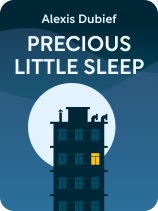

This article is an excerpt from the Shortform book guide to "Precious Little Sleep" by Alexis Dubief. Shortform has the world's best summaries and analyses of books you should be reading.
Like this article? Sign up for a free trial here.
What’s the fading method of sleep training? How can you implement this method in your daily routine as a new parent?
Alexis Dubief outlines two assisted sleep methods, also known as fading methods, that will help your baby learn to fall asleep without you. ASM requires your involvement, commitment, and patience, as the process can take days to weeks.
Let’s look at how to train your baby to independently sleep using the fading method.
The Assisted Sleep Method
To implement the fading method of sleep training, read through the options and pick one to try for at least five to seven days. If that one doesn’t work, move on to a different ASM technique. You’ll know that your independent sleep teaching is successful when your baby wakes up less frequently at night, if at all, and when putting your baby to sleep is easy, timely, and enjoyable.
(Shortform note: In addition to helping your baby get more sleep at night and improving your experience at bedtime, some research has shown that independent sleep training, like ASM, can improve the quality of your sleep as a parent and reduce postnatal depression in mothers.)
Option #1: Let Baby Fuss
This option is appropriate for babies 2 months and older.
- First, deploy all your soothing methods, including sleep aids and unsustainable associations like nursing, to get your baby drowsy.
- Put your baby down in their crib, sleepy but still awake.
- Walk away, allowing them 15-20 minutes of fussing and crying before returning to soothe them again. This fussing period gives them a chance to fall asleep on their own.
- If they fall asleep on their own, congratulations—this is your new strategy.
- If they don’t fall asleep after the waiting period, you have several options. If your baby is awake but not fussing too much, wait longer and see what happens. If they’re screaming, consider waiting a few more minutes. Some babies go from screaming to sleeping without a transition. If your baby is like this, listen to your parental instinct—they might fall asleep any second, or it might be a failed experiment, which is OK. If needed, go back and soothe your baby. Try again, or wait to try for a few days.
| Examining the 20-Minute Wait Time Other sleep experts also recommend waiting up to 20 minutes to give your baby a chance to fall asleep, saying that it typically takes most babies 5-20 minutes. Anything outside of this window may indicate problems: If it takes your baby less than 5 minutes to fall asleep but then they’re waking during the night or waking too early, they may be overtired, prompting their bodies to create stress hormones which interfere with sound sleep. Conversely, if it takes them more than 20 minutes to fall asleep, it’s possible they’re not tired enough. Dubief isn’t explicit about why it’s OK to use unsustainable sleep aids to help your baby get sleepy with this method. Other infant sleep experts explain that sleep associations are cues your baby associates with falling asleep, not getting sleepy. As long as you put your baby down while they’re still awake, none of your soothing methods, be they sleep aids or nursing, will become sleep associations. |
Option #2: Progressive Weaning
Babies who need your help to fall asleep tend to favor movement and physical contact (snuggling, bouncing, and rocking) or sucking (nursing and pacifier). Each category requires a different approach to give your baby more sleep independence incrementally. You’ll gradually reduce your involvement in the soothing process over days or weeks. Progressive weaning is appropriate for babies 2 to 6 months old.
(Shortform note: Other sleep experts commonly refer to progressive weaning strategies as Camping Out sleep training. Contrary to Dubief, they say camping out methods are suitable for a wide range of ages, from infants to older children. You can expect the process to take two to four weeks, and you should see improvements to your child’s sleep, with a reduction in night wakings, within that time period.)
For Movement-and-Touch Babies
- Rock or bounce your baby until they’re drowsy. Then put them in their crib, still awake.
- Gently jiggle and rock the crib until they fall asleep. At first, it may take them a long time to fall asleep—up to 30 minutes.
- The following nights, spend progressively less time jiggling the crib, reducing the duration by five minutes a night until you no longer need to jiggle.
- When you no longer need to jiggle the crib, simply put your baby down when they’re calm but awake and leave the room.
(Shortform note: This technique assumes that you have a crib that is easily, safely, and effectively rock-able. If your crib is too sturdy or heavy to rock, or doing so will compromise its structural integrity, look into purchasing a vibrating mattress pad or a full vibrating mattress, which create a similar soothing effect for babies and which research has shown can provide significant improvements in infant sleep quality.)
For Suckling Babies
The author says the best time to wean babies from their sleep associations with nursing, bottles, or pacifiers is before 5 months old. Start by allowing your baby to suckle before they go to sleep, but not while they fall asleep: Let them nurse, feed, or use a pacifier until they’re drowsy, then remove the suckling source and place them in the crib awake. If they remain calm, leave them to fall asleep on their own. If they protest, return the suckling source to re-settle them, then remove it again before they fall asleep. Repeat this cycle until they fall asleep without suckling. You might have to repeat the steps for the first few nights. Don’t give up. Eventually, a routine will emerge—a brief period of suckling followed by falling asleep by themselves in their crib.
(Shortform note: This method of returning to your baby to resettle them is often called the Pick-Up-Put-Down method (PUPD). While research on PUPD’s effectiveness is limited compared to other more well-known methods, some infant sleep experts consider it a high-soothing approach that provides comfort and reassurance during the sleep training process.)

———End of Preview———
Like what you just read? Read the rest of the world's best book summary and analysis of Alexis Dubief's "Precious Little Sleep" at Shortform.
Here's what you'll find in our full Precious Little Sleep summary:
- Techniques and pointers for improving your baby’s sleep
- Practical guidelines for infant sleep safety
- A nap chart to help you understand your child’s nap needs according to age






